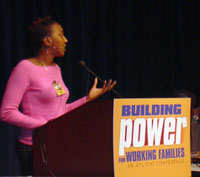Union activists demand increased diversity in leadership
By
David Sole
Chicago
Published Jul 28, 2005 9:06 PM
July 24—Hundreds of union
officers and members gathered here on July 23 for a “National Summit on
Diversity in Our Union Movement” sponsored by the AFL-CIO. More than 800
activists registered for the weekend, often filling the Sheraton Ballroom during
the various sessions.
|
Student activist
Felicia Ricks
addresses the
Diversity Summit.
|
The large majority of those at the event, which was
held for two days prior to the start of the National AFL-CIO Convention, were
not delegates to the full convention.
Many of the participants were
active in six “constituency groups” sanctioned by the AFL-CIO: the
Coalition of Black Trade Unionists (CBTU), Pride at Work, Asian Pacific American
Labor Alliance, Con ference of Labor Union Women, the A. Philip Randolph
Institute and the Labor Council for Latin American Advancement.
The
looming struggle inside the AFL-CIO, which might result in a boycott or even a
split in the federation, was clearly on everyone’s mind. But the
representatives from all the various unions in the weekend summit showed that
labor activists are unified in their desire to broadly increase diversity in the
union leadership and vastly increase organizing among the 88 percent of the
workforce that is not unionized.
AFL-CIO President John Sweeney and
Executive Vice-President Linda Chavez Thompson both spoke at the summit. They
stressed pledges that the AFL-CIO International Executive Board would add more
women and representatives of color. It was also announced that the 2009 AFL-CIO
national convention would seat only those union delegations that represented the
diversity of their membership.
But in some frank remarks later in the day,
Bill Lucy, secretary treasurer of the CBTU, told the crowd that it was only with
the threatened split in the federation that “we suddenly got a lot of
friends” and promises to increase diversity in the top
leadership.
Many panels of speakers were presented. Floor discussion was
limited. Several groups intervened on the important questions of war and
Pentagon spending by distributing written statements to summit
participants.
The Million Worker March Movement distributed a statement to
participants emphasizing that, “The AFL-CIO’s opposition to support
the Million Worker March in 2004, once again sends a message to the corporate
rulers, that labor-management cooperation and collaboration with the two
corporate parties, including U.S. foreign policy of war and empire, is at the
heart of labor’s strategy for survival and ‘growth.’”
Organizers for the National Conference to Reclaim Our Cities handed out
700 copies of a brochure entitled “Money for our cities, not for
war!” The event, to be held in Detroit Nov. 11-13, 2005, links the crisis
of the cities directly to the bloated Pentagon budget and calls for a national
fight-back campaign to “Feed the cities, starve the
Pentagon.”
Hundreds of union representatives also had a chance to
read an informative leaflet from the International Action Center about the U.S.
government’s attempt to undermine the pro-worker government of Hugo
Chávez in Vene zuela. It exposed the AFL-CIO’s collaboration with
the Bush administration, the CIA and the National Endowment for Democracy,
calling for the AFL to break with these right-wing agencies.
Workers World
newspaper, with a special appeal to the AFL-CIO convention to “Organize,
don’t split,” got into the hands of hundreds of unionists and was
well received.
Articles copyright 1995-2012 Workers World.
Verbatim copying and distribution of this entire article is permitted in any medium without royalty provided this notice is preserved.
Workers World, 55 W. 17 St., NY, NY 10011
Email:
[email protected]
Subscribe
[email protected]
Support independent news
DONATE


